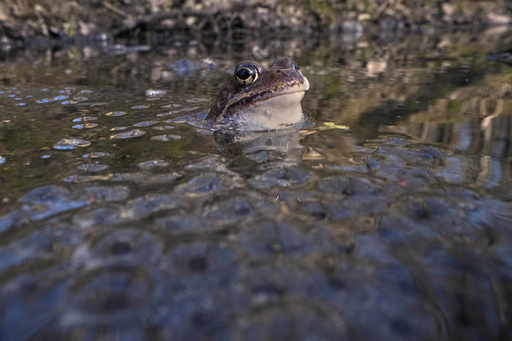At a nature reserve close to Sestroretsk in Russia, an intriguing event unfolds each spring. Along a stretch of road north of St. Petersburg, volunteers don yellow vests and take on the role of crossing guards for the myriad toads and frogs embarking on their journey to breeding grounds.
Despite limited traffic on this road, the few vehicles that do pass pose a danger to these amphibians. Konstantin Milta, a leading herpetologist at the St. Petersburg Zoological Institute, notes that even sparse traffic levels can result in the death of up to 1,000 toads annually. The situation is even more dire on busier highways where the casualties can cover the road with their lifeless forms.
To address this, a bold reddish-orange sign with an amphibian illustration alerts drivers with messages urging caution: “Attention! Slow down! Toads are crossing the road.” When volunteers spot a wayfaring toad, they gently place it into a plastic bucket, document the encounter, and release it safely into the grass on the other side of the road.
The scene is quite charming, as one volunteer exclaimed while a toad latched onto her pink glove. In this Sestroretsk Bog reserve, the amphibians undertake a cyclical migratory path from the forest to the bay each spring. Here, they breed and lay eggs in the reed beds, before retracing their path back to the forest around mid-May.
The initiative to safeguard these creatures began in 2016, as explained by Viktoria Samuta, the head of the environmental education sector at the Directorate of Protected Areas in St. Petersburg. Depending on the climate conditions, the effort runs from mid-April for over a month, enlisting more than 700 volunteers annually. Samuta proudly shared that in the previous year, volunteers successfully relocated thousands of toads.
She is heartened by the increasing number of individuals eager to lend a hand. “It is very promising that in recent years there has been a growing inclination to assist living creatures. Our aim is to inspire a growing love and willingness to protect nature,” Samuta remarked.
For volunteer Diana Kulinichenko, this act of conservation provides a refreshing escape from her academic responsibilities. Expressing her enthusiasm, she stated, “I’ve been longing all semester to escape to the forest. Here, amidst the trees and toads, I get to aid these creatures, breathe in the invigorating fresh air, and volunteer. It’s motivational, and I’m eager to find other opportunities for volunteering after this.”



